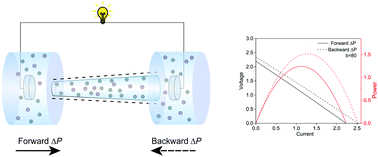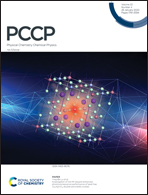Electrokinetic power generation in conical nanochannels: regulation effects due to conicity†
Abstract
Electrokinetic power generation is a promising clean energy production technology, which utilizes the electric double layer in a nanochannel to convert the hydrodynamic energy to electrical power. Previous research largely focused on electrokinetic power generation in nanochannels with a uniform cross-section. In this work, we perform a systematic investigation of electrokinetic power generation in a conical nanochannel. For this purpose, a multiphysical model consisting of the Planck–Nernst–Poisson equations and the Navier–Stokes equation is formulated and solved numerically. In particular, we discover various regulation effects in electrokinetic power generation in conical nanochannels, which manifest as the difference in the power generation characteristics (streaming potential, streaming current and current–voltage relationship) between two opposite pressure differences of the same magnitude. These regulation effects are found to originate from the conicity of the nanochannel. Furthermore, the regulation parameters are defined to quantify the observed regulation effects. Various regulation parameters can be up to severals tens of percent under extreme conditions (e.g., large pressure difference, high surface charge density or large conicity), indicating the substantial significance of the regulation effects in electrokinetic power generation. The conclusions from this work can serve as an important reference for the design and operation of nanofluidic electrokinetic power generation devices.



 Please wait while we load your content...
Please wait while we load your content...